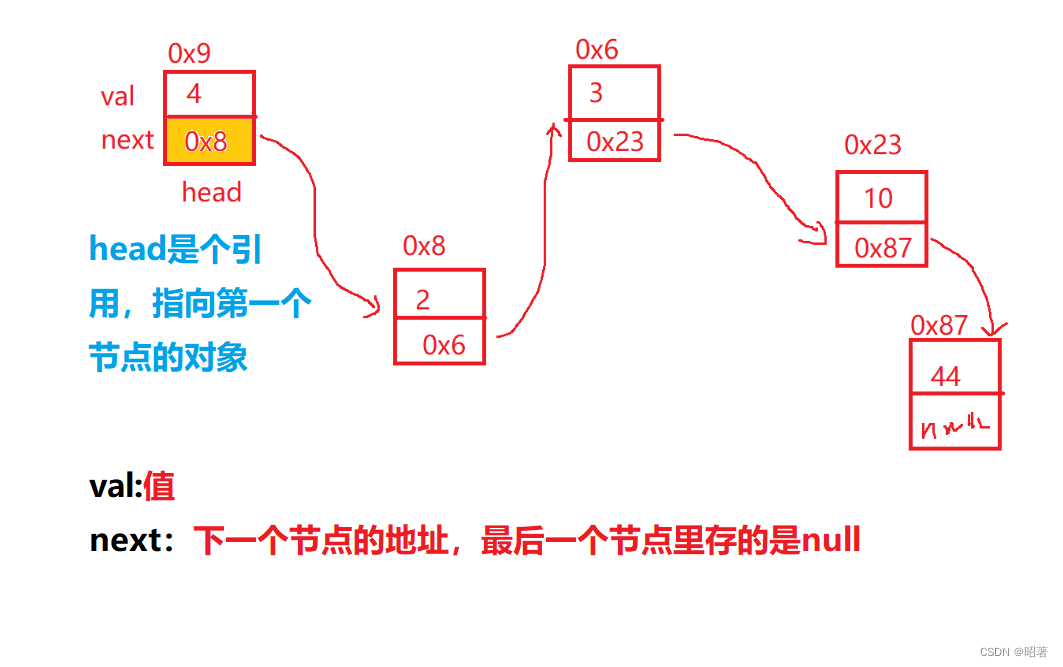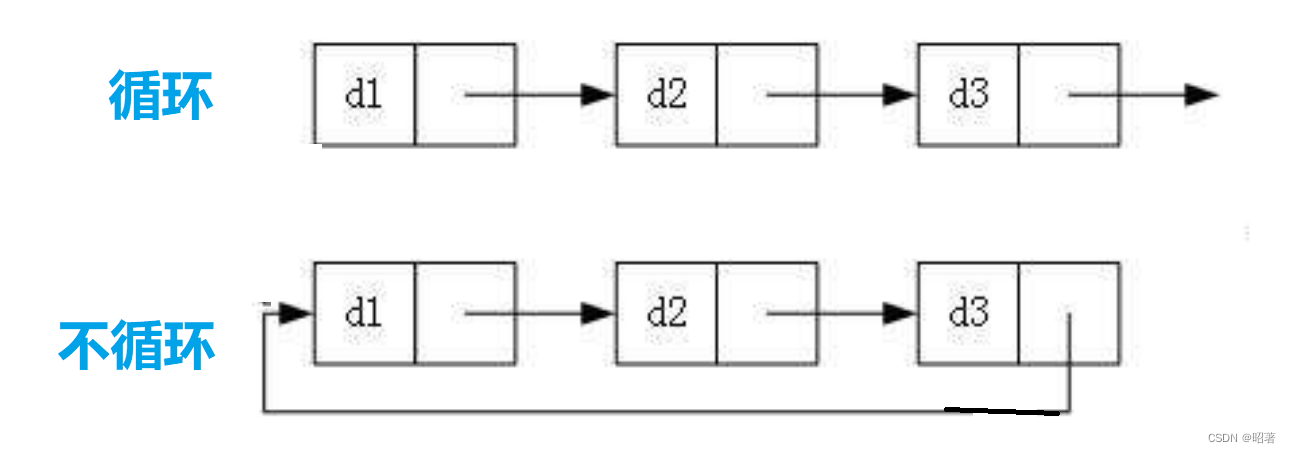数据结构初阶(链表)

文章目录
- 一、链表的基础概念
-
- 1.1 什么是链表
- 1.2 分类
- 1.3 链表的底层代码
- 1.4 例题
- 1.5 LinkedList 的实现
-
- (1)什么是LInkedList
- (2)底层代码
- (3)LinkedLIst的使用
- 1.6 ArrayList和LinkedList的区别
一、链表的基础概念
用于解决 ArrayList 中,插入、删除时间复杂度较大,且可能会浪费空间的问题
1.1 什么是链表
逻辑上是连续的,物理上(内存上)是不连续的,由一个个节点组成

1.2 分类
-
单向 / 双向

-
带头的 / 不带头的

-
循环 / 非循环

1.3 链表的底层代码
public class MyStringList {private ListNode head;class ListNode{private int val;private ListNode next;public ListNode(int val) {this.val = val;}}public void creatList(){ListNode node1 = new ListNode(12);ListNode node2 = new ListNode(24);ListNode node3 = new ListNode(36);ListNode node4 = new ListNode(48);node1.next = node2;node2.next = node3;node3.next = node4;node4.next = null;head = node1;}//打印这个链表的所有元素public void display() {ListNode cur = head;while (cur != null){System.out.print(cur.val + " ");cur = cur.next;}System.out.println();}//得到单链表的长度public int size(){int count = 0;ListNode cur = head;while (cur != null){count++;cur = cur.next;}return count;}//查找是否包含关键字key是否在单链表当中public boolean contains(int key){ListNode cur = head;while (cur != null){if (cur.val == key){return true;}cur = cur.next;}return false;}//头插法public void addFirst(int data){ListNode node = new ListNode(data);node.next = head;head = node;}//尾插法//要考虑是一个节点的情况public void addLast(int data){ListNode node = new ListNode(data);if (head == null){head = node;return;}ListNode cur = head;while (cur.next != null){cur = cur.next;}cur.next = node;}//任意位置插入,第一个数据节点为0号下标public void addIndex(int index,int data){ListNode cur = head;ListNode node = new ListNode(data);if (!checkIndex(index)){throw new IndexException("下标输入错误 " + index);}if (index == 0){addFirst(data);return;}if (index == this.size()){addLast(data);}//找到for (int i = 0; i < index - 1; i++) {cur = cur.next;}//交换node.next = cur.next;cur.next = node;}private boolean checkIndex(int index){if (index < 0 || index > this.size() ){return false;}return true;}//删除第一次出现关键字为key的节点public void remove(int key){if (head == null){return;}if (head.val == key){head = head.next;return;}ListNode prev = searchPrev(key);if (prev == null){System.out.println("没有这个数据");return;}ListNode del = prev.next;prev.next = del.next;}private ListNode searchPrev(int key){ListNode prev = head;while (prev.next != null){if (prev.next.val == key){return prev;}else{prev = prev.next;}}return null;}//删除所有值为key的节点public void removeAllKey(int key){if (head == null){return;}while (head.val == key){head = head.next;}ListNode cur = head.next;ListNode prev = head;while (cur != null){if (cur.val == key){prev.next = cur.next;cur = cur.next;}else {prev = cur;cur = cur.next;}}}public void clear() {//this.head = null; 第一种方法while (head != null) {ListNode headNext = head.next; //第二种方法head.next = null;head = headNext;}}
}
1.4 例题
一、移除链表元素
class Solution {public ListNode removeElements(ListNode head, int val) {if (head == null){return head;}ListNode cur = head.next;ListNode pre = head;while (cur != null){if (cur.val == val){cur = cur.next;pre.next = cur;}else{pre = cur;cur = cur.next;}}if (head.val == val){head = head.next;}return head;}
}
二、反转一个单链表
class Solution {public ListNode reverseList(ListNode head) {if (head == null){return null;}if (head.next == null){return head;}ListNode cur = head.next;head.next = null;while (cur != null){ListNode curNext = cur.next;cur.next = head;head = cur;cur = curNext;}return head;}
}
三、链表的中间节点
class Solution {public ListNode middleNode(ListNode head) {ListNode fast = head;ListNode slow = head;while (fast != null && fast.next != null){fast= fast.next.next;slow = slow.next;}return slow;}
}
四、链表中倒数第四个节点
public ListNode FindKthToTail(ListNode head,int k) {ListNode fast = head;ListNode slow = head;if (head == null || k <= 0){return null;}for(int i = 0; i < k - 1; i++){fast = fast.next;if (fast == null){return null;}}while (fast.next != null){slow = slow.next;fast = fast.next;}return slow;
}
五、合并两个有序链表
class Solution {public ListNode mergeTwoLists(ListNode list1, ListNode list2) {ListNode newHead = new ListNode();ListNode tmpH = newHead;while (list1 != null && list2 != null){if (list1.val < list2.val){tmpH.next = list1;tmpH = tmpH.next;list1 = list1.next;}else {tmpH.next = list2;tmpH = tmpH.next;list2 = list2.next;}}if (list1 != null){tmpH.next = list1;}else {tmpH.next = list2;}return newHead.next;}
}
六、链表分割
public class Partition {public ListNode partition(ListNode pHead, int x) {ListNode ae = null;ListNode as = null;ListNode be = null;ListNode bs = null;while (pHead != null){if (pHead.val < x){if (ae == null){ae = pHead;as = pHead;}else{as.next = pHead;as = as.next;}}else{if (be == null){be = pHead;bs = pHead;}else {bs.next = pHead;bs = bs.next;}}pHead = pHead.next;}if (ae == null){return be;}as.next = be;if (be != null){bs.next = null;}return ae;}
}
七、链表的回文结构
public class PalindromeList {public boolean chkPalindrome(ListNode A) {ListNode slow = A;ListNode fast = A;while (fast != null && fast.next != null){fast = fast.next.next;slow = slow.next;}//翻转ListNode cur = slow.next;while (cur != null){ListNode curNext = cur.next;cur.next = slow;slow = cur;cur = curNext;}//判断while (A != slow){if (A.val != slow.val){return false;}if (A.next == slow){return true;}A = A.next;slow = slow.next;}return true;}
}
八、相交链表
public ListNode getIntersectionNode(ListNode headA, ListNode headB) {ListNode plong = headA;ListNode pshort = headB;//1、分别求两个链表的长度int len1 = 0;int len2 = 0;//O(M)while (plong != null) {len1++;plong = plong.next;}//O(N)while (pshort != null) {len2++;pshort = pshort.next;}plong = headA;pshort = headB;//2、求差值步的lenint len = len1 - len2;if(len < 0) {plong = headB;pshort = headA;len = len2 - len1;}//3、哪个链表长 走len步while (len != 0) {plong = plong.next;len--;}//4、一起走 直到相遇!while (plong != pshort) {plong = plong.next;pshort = pshort.next;}return plong;}
九、环形列表
public class Solution {public boolean hasCycle(ListNode head) {if (head == null){return false;}ListNode fast = head;ListNode slow = head;while (fast != null && fast.next != null){fast = fast.next.next;slow = slow.next;if (fast == slow){return true;}}return false;}
}
十、环形列表||
public class Solution {public ListNode detectCycle(ListNode head) {if (head == null){return null;}ListNode slow = head;ListNode fast = head;while (fast != null && fast.next != null){fast = fast.next.next;slow = slow.next;if (fast == slow){break;}}if (fast == null || fast.next == null){return null;}fast = head;while (fast != slow){fast = fast.next;slow = slow.next;}return fast;}
}
1.5 LinkedList 的实现
(1)什么是LInkedList

(2)底层代码
public class MyLinkedList {static class ListNode {public int val;public ListNode prev;public ListNode next;public ListNode(int val) {this.val = val;}}public ListNode head;public ListNode last;//得到链表的长度 和双向 没有关系 !!!public int size(){int len = 0;ListNode cur = head;while (cur != null) {cur = cur.next;len++;}return len;}public void display(){ListNode cur = head;while (cur != null) {System.out.print(cur.val+" ");cur = cur.next;}System.out.println();}//查找是否包含关键字key是否在链表当中public boolean contains(int key){ListNode cur = head;while (cur != null) {if(cur.val == key) {return true;}cur = cur.next;}return false;}//头插法public void addFirst(int data){ListNode node = new ListNode(data);if(head == null) {head = node;last = node; //第一种写法return;}node.next = head;head.prev = node;head = node;/*if(head == null) {head = node;}else { //第二种写法node.next = head;head.prev = node;head = node;}*/}//尾插法public void addLast(int data){ListNode node = new ListNode(data);if(head == null) {head = node;last = node;}else {last.next = node;node.prev = last;last = node;//last = last.next;}}//任意位置插入,第一个数据节点为0号下标public void addIndex(int index,int data){int size = size();if(index < 0 || index > size) {throw new IndexOutOfBounds("双向链表index不合法!");}if(index == 0) {addFirst(data);return;}if(index == size) {addLast(data);return;}ListNode cur = head;while (index != 0) {cur = cur.next;index--;}ListNode node = new ListNode(data);node.next = cur;cur.prev.next = node;node.prev = cur.prev;cur.prev = node;}//删除第一次出现关键字为key的节点public void remove(int key){ListNode cur = head;while (cur != null) {if(cur.val == key) {//开始删if(cur == head) {//删除头节点head = head.next;//只要1个节点的时候if(head != null) {head.prev = null;}else {last = null;}}else {cur.prev.next = cur.next;if(cur.next != null) {//cur.prev.next = cur.next;cur.next.prev = cur.prev;}else {//cur.prev.next = cur.next;last = last.prev;}}return;}else {cur = cur.next;}}}//删除所有值为key的节点public void removeAllKey(int key){ListNode cur = head;while (cur != null) {if(cur.val == key) {//开始删if (cur == head) {//删除头节点head = head.next;//只要1个节点的时候if (head != null) {head.prev = null;}else {last = null;}} else {cur.prev.next = cur.next;if (cur.next != null) {//cur.prev.next = cur.next;cur.next.prev = cur.prev;} else {//cur.prev.next = cur.next;last = last.prev;}}}cur = cur.next;}}public void clear(){ListNode cur = head;while (cur != null) {ListNode curNext = cur.next;cur.prev = null;cur.next = null;//cur.val = null; 如果cur.val是引用的情况cur = curNext;}head = null;last = null;}
}(3)LinkedLIst的使用
❤️构造
| 方法 | 解释 |
| LinkLIst() | 无参构造 |
| public LinkedList(Collection<? extends E>c) | 使用其他集合容器中元素构造List |
List<Integer> list1 = new LinkedList<>();
List<String> list2 = new LinkedList<>();
List<String> list3 = new LinkedList<>(list2);
❤️方法
| 方法 | 解释 |
| boolean add(E e) | 尾插 e |
| void add(int index, E element) | 将 e 插入到 index 位置 |
| boolean addAll(Collection<? extends E> c) | 尾插 c 中的元素 |
| E remove(int index) | 删除 index 位置元素 |
| boolean remove(Object o) | 删除遇到的第一个 o |
| E get(int index) | 获取下标 index 位置元素 |
| E set(int index, E element) | 将下标 index 位置元素设置为 element |
| void clear() | 清空 |
| boolean contains(Object o) | 判断 o 是否在线性表中 |
| int indexOf(Object o) | 返回第一个 o 所在下标 |
| int lastIndexOf(Object o) | 返回最后一个 o 的下标 |
| List subList(int fromIndex, int toIndex) | 截取部分 list |
❤️遍历
public static void main(String[] args) {LinkedList<Integer> list = new LinkedList<>();list.add(1); // add(elem): 表示尾插list.add(2);list.add(3);list.add(4);list.add(5);list.add(6);list.add(7);System.out.println(list.size());//直接打印System.out.println(linkedList);// foreach遍历for (int e:list) {System.out.print(e + " ");}System.out.println();// 使用迭代器遍历---正向遍历ListIterator<Integer> it = list.listIterator();while(it.hasNext()){System.out.print(it.next()+ " ");}System.out.println();// 使用反向迭代器---反向遍历ListIterator<Integer> rit = list.listIterator(list.size());while (rit.hasPrevious()){System.out.print(rit.previous() +" ");}System.out.println();
}
1.6 ArrayList和LinkedList的区别
| 不同点 | ArrayList | LInkedList |
| 存储空间上 | 物理上一定连续 | 逻辑上连续,但物理上不一定连续 |
| 随机访问 | 支持O(1) | 不支持:O(N) |
| 头插 | 需要搬移元素,效率低O(N) | 只需修改引用的指向,时间复杂度为O(1) |
| 插入 | 空间不够时需要扩容 | 没有容量的概念 |
| 应用场景 | 元素高效存储+频繁访问 | 任意位置插入和删除频繁 |


